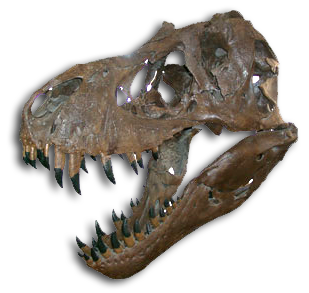Item Number
2165
Type
image
Description
Baby Mammoth
Age
Cenozoic, Quaternary, Pleistocene Epoch (2.6 MYA to 11,700 years ago)
SciId
Mammuthus primigenius
Status
in inventory
Display/Storage
Display
Building
Zuhl Museum
Original Site
Alaska
Date Acquired
2018
Source
Hagar's Fossils and Minerals
Gallery/Room\Floor
History of Life Gallery
Notes
Nicknamed: Borealis. Height: 3 ft. 6 inches, Length: 5 ft. 5 inch – Tail to tusk tip. Found in a Gold Mine North of Fairbanks Alaska. Baby Mammoths are RARE in the fossil record. Predators typically ate them and what wasn't eaten disintegrated due to the thinness of the immature bones. This little mammoth had the back of its skull chewed on by a large predator, such as a lion (after death, once frozen and buried in ice most likely). Other baby mammoth material replaced missing elements. It has roughly 25% repair. Woolly mammoths were closely related to today's Asian elephants. They looked a lot like their modern cousins, except for one major difference. They were covered in a thick coat of brown hair to keep them warm in their home on the frigid Arctic plains. They even had fur-lined ears. The most recent Ice Age occurred during the Pleistocene Epoch, as glaciers covered huge parts of the planet Earth. It is the first in which Homo sapiens evolved, and by the end of the epoch, nearly every part of the planet contained humans. The Pleistocene Epoch was the first epoch in the Quaternary Period and the sixth in the Cenozoic Era. The current Holocene Epoch followed. Most mammoth populations had died out by around 10,000 years ago although a small population of 500-1000 woolly mammoths lived on Wrangel Island in the Arctic until as recently as 1650 BC. This was approximately 1000 years after the pyramids at Giza were built.
Preview

Description
Nicknamed: Borealis. Height: 3 ft. 6 inches, Length: 5 ft. 5 inch – Tail to tusk tip. Found in a Gold Mine North of Fairbanks Alaska. Baby Mammoths are RARE in the fossil record. Predators typically ate them and what wasn't eaten disintegrated due to the thinness of the immature bones. This little mammoth had the back of its skull chewed on by a large predator, such as a lion (after death, once frozen and buried in ice most likely). Other baby mammoth material replaced missing elements. It has roughly 25% repair. Woolly mammoths were closely related to today's Asian elephants. They looked a lot like their modern cousins, except for one major difference. They were covered in a thick coat of brown hair to keep them warm in their home on the frigid Arctic plains. They even had fur-lined ears. The most recent Ice Age occurred during the Pleistocene Epoch, as glaciers covered huge parts of the planet Earth. It is the first in which Homo sapiens evolved, and by the end of the epoch, nearly every part of the planet contained humans. The Pleistocene Epoch was the first epoch in the Quaternary Period and the sixth in the Cenozoic Era. The current Holocene Epoch followed. Most mammoth populations had died out by around 10,000 years ago although a small population of 500-1000 woolly mammoths lived on Wrangel Island in the Arctic until as recently as 1650 BC. This was approximately 1000 years after the pyramids at Giza were built. 3 ft. 6 inches, Length: 5 ft. 5 inches
Keywords
Baby Mammoth Nicknamed: Borealis. Height: 3 ft. 6 inches, Length: 5 ft. 5 inch – Tail to tusk tip. Found in a Gold Mine North of Fairbanks Alaska. Baby Mammoths are RARE in the fossil record. Predators typically ate them and what wasn't eaten disintegrated due to the thinness of the immature bones. This little mammoth had the back of its skull chewed on by a large predator, such as a lion (after death, once frozen and buried in ice most likely). Other baby mammoth material replaced missing elements. It has roughly 25% repair. Woolly mammoths were closely related to today's Asian elephants. They looked a lot like their modern cousins, except for one major difference. They were covered in a thick coat of brown hair to keep them warm in their home on the frigid Arctic plains. They even had fur-lined ears. The most recent Ice Age occurred during the Pleistocene Epoch, as glaciers covered huge parts of the planet Earth. It is the first in which Homo sapiens evolved, and by the end of the epoch, nearly every part of the planet contained humans. The Pleistocene Epoch was the first epoch in the Quaternary Period and the sixth in the Cenozoic Era. The current Holocene Epoch followed. Most mammoth populations had died out by around 10, 000 years ago although a small population of 500-1000 woolly mammoths lived on Wrangel Island in the Arctic until as recently as 1650 BC. This was approximately 1000 years after the pyramids at Giza were built. 2018 Cenozoic, Quaternary, Pleistocene Epoch (2.6 MYA to 11, 700 years ago) Fossil
Keywords
Baby Mammoth Nicknamed: Borealis. Height: 3 ft. 6 inches, Length: 5 ft. 5 inch – Tail to tusk tip. Found in a Gold Mine North of Fairbanks Alaska. Baby Mammoths are RARE in the fossil record. Predators typically ate them and what wasn't eaten disintegrated due to the thinness of the immature bones. This little mammoth had the back of its skull chewed on by a large predator, such as a lion (after death, once frozen and buried in ice most likely). Other baby mammoth material replaced missing elements. It has roughly 25% repair. Woolly mammoths were closely related to today's Asian elephants. They looked a lot like their modern cousins, except for one major difference. They were covered in a thick coat of brown hair to keep them warm in their home on the frigid Arctic plains. They even had fur-lined ears. The most recent Ice Age occurred during the Pleistocene Epoch, as glaciers covered huge parts of the planet Earth. It is the first in which Homo sapiens evolved, and by the end of the epoch, nearly every part of the planet contained humans. The Pleistocene Epoch was the first epoch in the Quaternary Period and the sixth in the Cenozoic Era. The current Holocene Epoch followed. Most mammoth populations had died out by around 10, 000 years ago although a small population of 500-1000 woolly mammoths lived on Wrangel Island in the Arctic until as recently as 1650 BC. This was approximately 1000 years after the pyramids at Giza were built. 2018 Cenozoic, Quaternary, Pleistocene Epoch (2.6 MYA to 11, 700 years ago) Fossil


